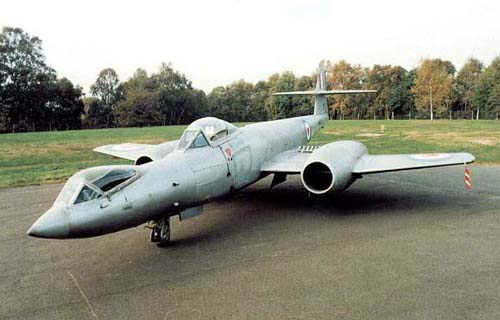- Gloster Meteor F8 "Prone Pilot"
infobox Aircraft
name =Gloster Meteor F8 "Prone pilot"
type =Experimental aircraft
manufacturer =Armstrong-Whitworth
caption =
designer =
first flight =10 February 1954
introduced =1954
retired =
status =Prototype
primary user =Royal Air Force
more users =
produced =
number built = 1
unit cost =
variants with their own articles =A much modifiedGloster Meteor F8 fighter, the "prone position"/"prone pilot" Meteor, was used to evaluate the advantages of coping with the effects of inertial forces expressed as a multiple of those due to the acceleration due to gravity "g" while flying in a prone or lying down position. Along with the Reid and Sigrist R.S.4 "Bobsleigh", the Gloster Meteor was engaged in a proof-of-concept experimental programme that proved in practice the difficulties of operating the controls of the aircraft outweighed the advantages of sustaining higher g effects.Design and development
In the early 1950s the adoption of a prone position cockpit in future combat aircraft designs appeared attractive for two reasons. Firstly, such a configuration enabled the frontal area of the airframe to be reduced and therefore reduced drag. Secondly, aircrew can withstand greater inertial forces if not sitting upright, a vital consideration given the need for jet combat aircraft to manoeuvre at ever increasing speeds. While the Reid and Sigrist R.S.4 "Bobsleigh" explored low speed performance 1951-1956, the
Royal Air Force soon also needed a higher performance concept aircraft.Testing and evaluation
The
Bristol Aeroplane Company sought to exploit these advantages by incorporating a prone pilot position in its proposal for a rocket powered fighter, the Bristol Type 185. In order to establish the viability of a prone pilot cockpit, theRAF Institute of Aviation Medicine required a jet aircraft that could be flown in experimental flight tests. The last production Meteor F8 WK935 built byArmstrong-Whitworth was selected for modification and joined the Institute of Aviation Medicine in autumn 1954.Armstrong-Whitworth carried out all the modifications as an "in-house" project. A standard fighter cockpit was retained and "WK935" was never flown solo from the front cockpit which incorporated a custom-built coach, offset tiny control column, suspended rear pedals and a radically modified cockpit. A Meteor NF 12 tail unit was substituted for the usual F8 tail. Jones 1998, p. 156] The Armstrong-Whitworth Chief Test Pilot Eric George Franklin carried out the test flights. Young 1985, p. 83.]
The prone pilot's emergency escape involved an extremely complex procedure which included jettisoning the rudder pedals, crawling backward to an escape hatch and retracting the nose wheel. Fortunately, this system was never used.
Following some 55 hours of flight testing over 99 flights, the results were inconclusive; although the prone position concept was feasible, the development of special aviation clothing offered a simpler solution to the problem of counteracting inertial forces and the prone position Meteor was no longer needed. Although prone pilots were able to control the aircraft as well as a standard Meteor, the extreme forward position with limited rear view, presented a problem in mock combat with conventional aircraft .
Meteor F8 "WK935" was retired after a year and after storage at No. 12 Maintenance Unit, the aircraft was sent to RAF Colerne before being preserved at the
RAF Museum Cosford in the UK.Operators
;UK
*Royal Air Force pecifications (Meteor F.8 modified)
aircraft specifications
plane or copter?=plane
jet or prop?=jet
ref=The Great Book of Fighters [Green 2001]
crew=1
length main=52 ft 5 in
length alt=15.9 m
span main=37 ft 2 in
span alt=11.32 m
height main=13 ft 0 in
height alt=3.96 m
area main=350 ft²
area alt=32.52 m²
empty weight main=10,684 lb
empty weight alt=4,846 kg
loaded weight main=15,700 lb
loaded weight alt=7,121 kg
max takeoff weight main=
max takeoff weight alt=
engine (jet)=Rolls-Royce Derwent 8
type of jet=turbojet s
number of jets=2
thrust main=3,500 lbf
thrust alt=15.6 kN
max speed main=Mach 0.82, 600 mph at 10,000 ft
max speed alt=965 km/h at 3,050 m
ceiling main=43,000 ft
ceiling alt= 13,100 m
range main=600 mi
range alt=965 km
climb rate main=7,000 ft/min
climb rate alt=35.6 m/s
loading main= 44.9 lb/ft²
loading alt= 149 kg/m²
thrust/weight=0.45
more performance=
*Time to altitude: 5.0 min to 30,000 ft (9,145 m)
armament=
*No armament was carriedee also
aircontent|
related=similar aircraft=
* Reid and Sigrist R.S.4 "Bobsleigh"
*Henschel Hs 132
* Lockheed EF-80
*Blohm & Voss BV 40 sequence=
Gauntlet - Gladiator - F.9/37- E.28/39 - Meteor - E.1/44 - Javelinsee also=
References
;Notes;Bibliography
* Ashley, Glenn. "Meteor in Action." Carrollton, Texas: Squadron/Signal Publications Inc., 1995. ISBN 0-89747-332-9.
* Bowyer, Chaz. "Gloster Meteor." London: Ian Allen Ltd., 1985. ISBN 0-7110-1477-9.
* Butler, Tony. "Gloster Meteor." Milton Keynes, Buckinghamshire, United Kingdom: Hall Park Books Ltd., 2001. ISBN 1-85780-230-6.
* Caruana, Richard J. and Franks, Richard A. "The Gloster & AW Meteor." Kingsway, Bedford, United Kingdom: SAM Publications, 2004. ISBN 0-9533465-8-7.
* Green, William and Swanborough, Gordon. "The Great Book of Fighters." St. Paul, Minnesota: MBI Publishing, 2001. ISBN 0-7603-1194-3.
* Jones, Barry. "Gloster Meteor." Ramsbury, Marlborough, Wiltshire, United Kingdom: The Crowood Press Ltd., 1998. ISBN 1-86126-162-4.
* Young, Michael G. "Prone Meteor." "Aviation News" Vol. 13, No. 22, 22 March-4 April 1985.External links
* [http://www.ctie.monash.edu.au/hargrave/MEGGS_meteor_gallery.html Gloster Meteor T7/F8]
* [http://www.rafmuseum.org.uk/gloster-meteor-f8-prone-position.htm Royal Air Force Museum: Gloster Meteor F8 Prone Position]
Wikimedia Foundation. 2010.
